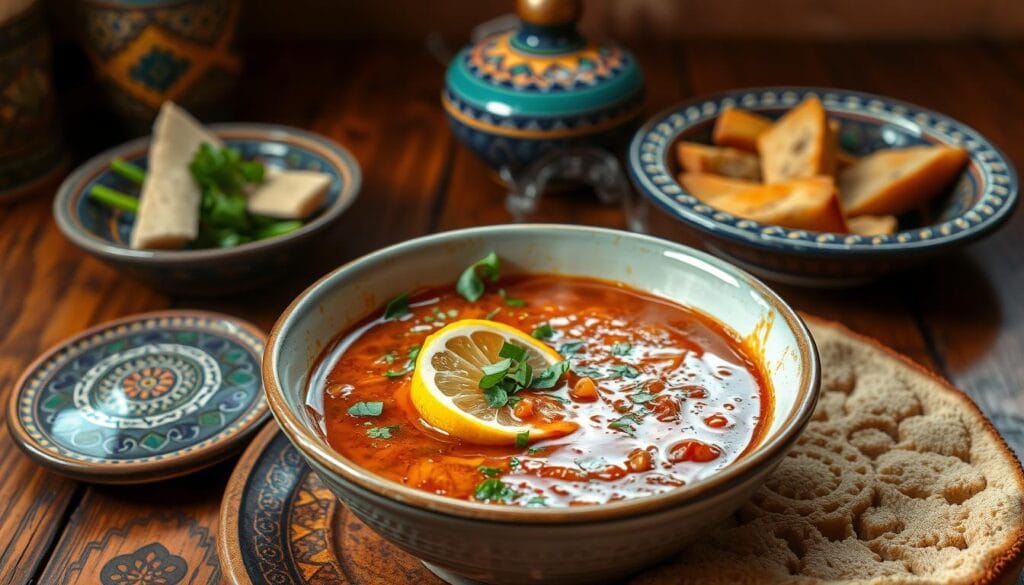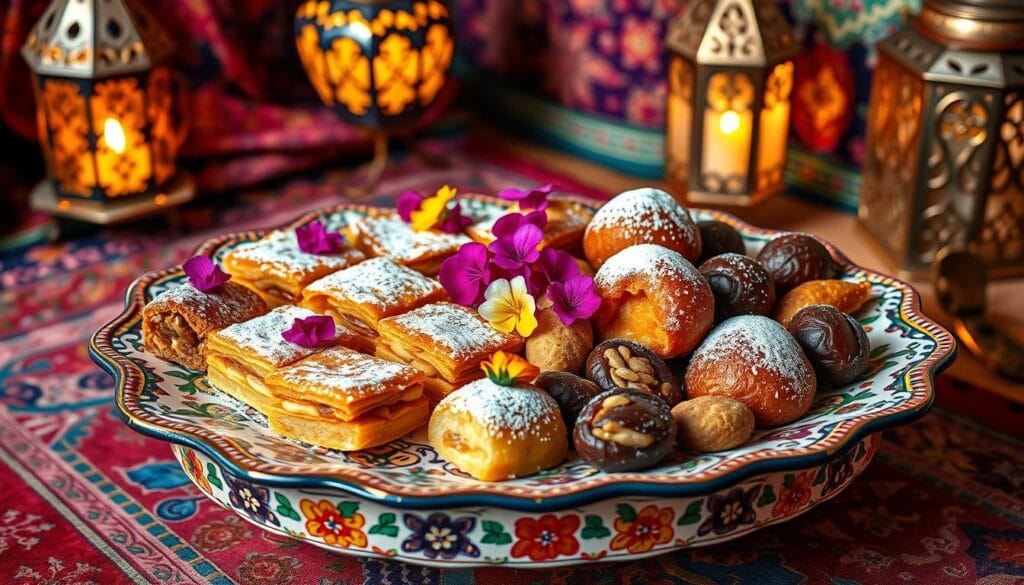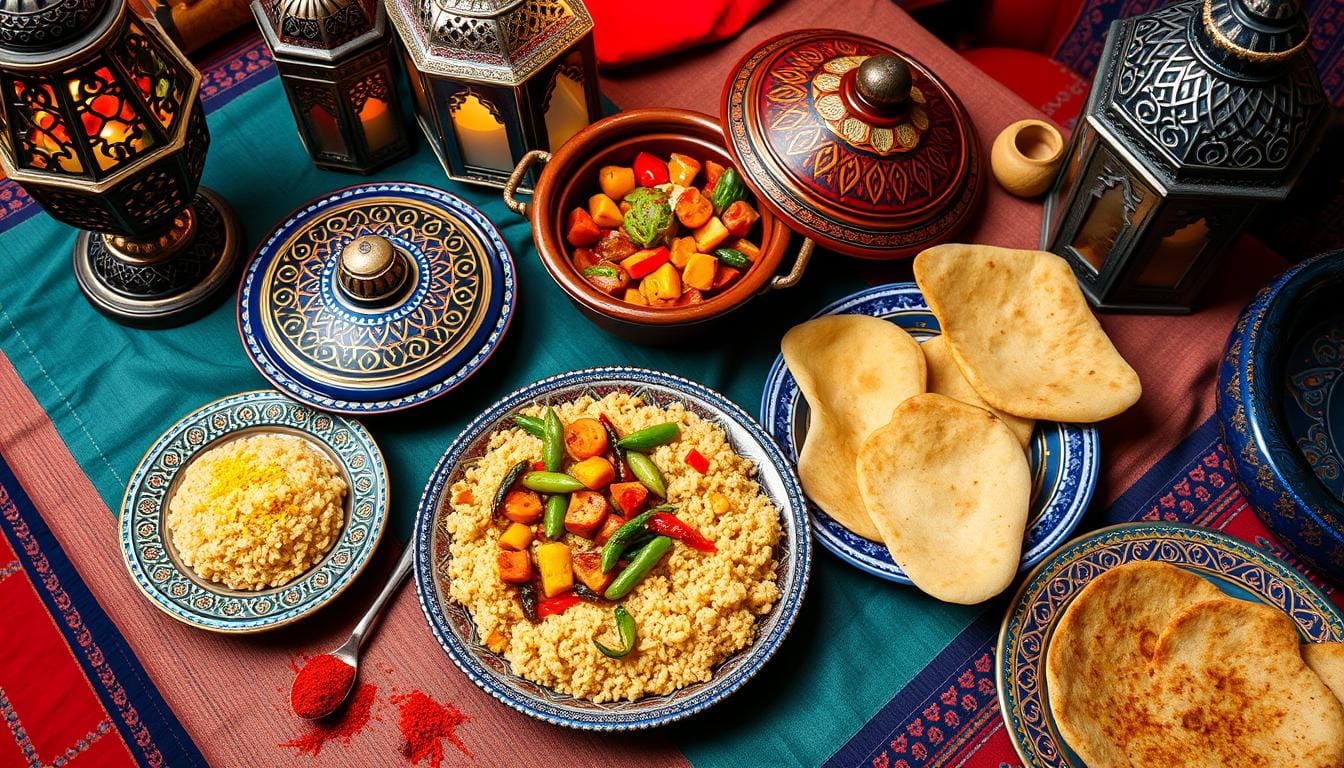Get ready for an amazing culinary adventure with authentic Moroccan recipes. Moroccan cooking blends Arab, Berber, Mediterranean, Andalusian, and European influences, creating a vibrant mix of flavors that has captured the hearts of food lovers worldwide.
Moroccan recipes are all about aromatic spices, layered ingredients, and time-honored traditions. From the fragrant tagines to the flaky pastries, each dish offers a unique and unforgettable taste experience.
In this article, we’ll dive into delicious Moroccan recipes. We’ll show you how to make these traditional dishes in your kitchen. Whether you’re an experienced cook or just starting out, you’ll find lots of inspiration and helpful tips to enhance your Moroccan cooking journey.
Understanding the Rich Heritage of Moroccan Cuisine
Moroccan cuisine is a mix of many cultures. It combines Berber, Arab, Mediterranean, and European flavors. The famous tagine dishes and the beloved couscous show the country’s rich history and creative cooking.
Origins and Cultural Influences
Morocco’s location between Europe, the Middle East, and Africa makes its cuisine unique. The use of spices like cumin, saffron, and ginger reflects Berber, Arab, and Moorish traditions. The special spice mix, ras el hanout, adds depth to Moroccan dishes.
Essential Moroccan Cooking Techniques
Slow-cooking is key in Moroccan cuisine, especially in tagine pots. These pots simmer meats, vegetables, and spices gently. The technique of making couscous is also important, steaming it with various toppings.
Traditional Cooking Vessels and Tools
Moroccan cuisine is not just about flavors but also about the tools used. Besides tagine pots, there are couscoussiers and traditional tea services. These tools add history and authenticity to Moroccan dishes.
Essential Spices and Ingredients in Moroccan Cooking
Moroccan cuisine is known for its bold flavors. This is thanks to the wide range of spices and ingredients used. Ras el hanout and preserved lemons are key to this rich culinary tradition.
The Moroccan spices are at the core of cooking here. They include cumin, coriander, paprika, turmeric, cinnamon, ginger, and saffron. Cumin is especially popular, used in ras-el-hanout and in dishes like tagines and rice.
Preserved lemons add a tangy taste to Moroccan dishes. They are cured in salt and lemon juice, changing their flavor and texture. Harissa, a spicy chile paste, adds heat and flavor.
Ras el hanout is a complex spice blend unique to Moroccan cooking. It can have up to 80 spices, including cardamom, nutmeg, and peppers. It’s used in special dishes, adding depth and character.
Other important ingredients include olives, chickpeas, almonds, and dried fruits like apricots and dates. These, along with traditional cooking methods, make Moroccan food so unique and flavorful.
Traditional Moroccan Tagine Recipes
Tagines are the iconic slow-cooked Moroccan stews. They are a big part of the country’s rich culinary heritage. These dishes are named after the distinctive conical clay pots they’re cooked in. This pot shape lets the ingredients simmer and meld together into a delightful symphony of tastes.
Lamb Tagine with Apricots and Almonds
The lamb tagine with apricots and almonds is a favorite. Tender lamb chunks are simmered with fragrant spices like cinnamon, cumin, and paprika. Sweet dried apricots and crunchy almonds add to the dish. The result is a well-balanced, slow-cooked dish that perfectly captures the authentic flavors of Moroccan cuisine.
Chicken Tagine with Preserved Lemons
The chicken tagine is another classic Moroccan dish. It’s cooked with preserved lemons and aromatic spices. The unique, tangy flavor of the preserved lemons complements the succulent chicken beautifully. This creates a dish that’s both comforting and complex.
Vegetable Tagine with Chickpeas
The vegetable tagine with chickpeas is a great meatless option. This slow-cooked stew features a medley of vegetables like carrots, zucchini, and onions. They’re all simmered in a flavorful tomato-based sauce and infused with the warm spices of Moroccan cuisine.
These slow-cooked Moroccan dishes are best served with fluffy couscous or traditional Moroccan bread. This way, you can soak up every last drop of the rich, aromatic sauce.
“Tagines are the heart and soul of Moroccan cooking, where the slow simmer of ingredients transforms into a symphony of flavors.”
Authentic Moroccan Recipes for Beginners
Explore the vibrant flavors of Moroccan cuisine with these easy recipes. Try chicken with lemon and olives or kefta (spiced meatballs). These dishes introduce you to Moroccan cooking without the fuss.
Kefta, a flavorful meatball recipe, is a hit in Morocco. Mix 500g of ground lamb, beef, or turkey with 1 tsp of paprika, a pinch of salt, and pepper. Shape into small meatballs and simmer in tomato sauce for 10-15 minutes. It serves 4 and pairs well with couscous or bread.
Zaalouk, a classic eggplant dip, is another easy choice. Roast and mash eggplants, then sauté with garlic, tomatoes, and spices like cumin and paprika. Enjoy it with warm Moroccan flatbread for a tasty appetizer.
For a satisfying meal, try Moroccan chicken with lemon and olives. Brown chicken thighs or drumsticks, then simmer in a flavorful broth with preserved lemons, olives, and spices. The slow cooking makes the chicken tender and full of Moroccan flavors.
These recipes are great for beginners. They let you dive into Moroccan cuisine’s rich traditions. With simple steps, you can make authentic Moroccan dishes at home.
Moroccan Bread and Flatbread Specialties
Moroccan cuisine is famous for its wide variety of breads. Each bread has its own taste and texture. From the flaky m’smen to the olive-studded Moroccan olive bread, these flatbreads are key to many dishes. Let’s dive into some of the top Moroccan bread and flatbread specialties that will make your meals better.
M’smen (Moroccan Flatbread)
M’smen, also known as msemmen, is a classic Moroccan flatbread. It’s known for its layers of buttery goodness. The dough is folded and stretched many times, making it flaky and slightly chewy.
This bread is often served with stews and tagines. It’s also great as a base for dips and spreads. This shows how versatile m’smen is in Moroccan cuisine.
Moroccan Olive Bread
Moroccan olive bread, or khobz bil-zaytoun, is a savory flatbread. It’s made with green olives, giving it a unique flavor. You can find this bread in many Moroccan markets and bakeries.
The combination of the dough and the olives is amazing. Moroccan olive bread goes well with many stews and salads. It’s a favorite in the local cuisine.
Semolina Pancakes (Beghrir)
Beghrir, also known as Moroccan semolina pancakes, are a special breakfast treat. They have a lacy texture from semolina flour and yeast. Traditionally, beghrir are served warm with honey or your favorite toppings.
These Moroccan bread and flatbread specialties are not just tasty. They are also a big part of the country’s culinary history. Whether you’re enjoying m’smen, olive bread, or beghrir, these breads will make you appreciate Moroccan cuisine even more.
Flavorful Moroccan Soups and Stews
Moroccan cuisine is famous for its rich, aromatic soups and stews. These dishes are not just tasty but also deeply rooted in the country’s culture. One iconic soup is harira, a tomato-based soup enjoyed during Ramadan.
Harira is a comforting soup with lentils, chickpeas, meat, and warm spices like cumin and cinnamon. It’s thickened with flour or eggs, making it perfect for dipping bread.
Bissara is another popular soup, a hearty fava bean soup enjoyed in the cold months. It’s seasoned with garlic, olive oil, and paprika. It’s often served with olive oil and lemon juice.
Moroccan stews, or tagines, are also loved. They’re slow-cooked with meat, vegetables, and spices in a clay pot. You can find recipes like lamb with apricots and almonds, or chicken with preserved lemons.
Whether you crave a comforting harira or a savory tagine, Moroccan soups and stews will warm your soul and delight your taste buds.
Harira: A Ramadan Tradition
Harira is a beloved Moroccan soup enjoyed during Ramadan. It’s a hearty, tomato-based soup with lentils, chickpeas, meat, and spices. The soup is thickened with flour or eggs, making it velvety and comforting.
Harira is often served as a main dish or appetizer. Recipes vary, with some adding vermicelli or preserved butter for extra flavor. Some suggest using a pressure cooker to speed up cooking.
Harira is a cherished part of Moroccan cuisine, especially during Ramadan. It’s enjoyed to break the daily fast.

“Harira is a bold and flavorful comfort food, especially during the cold winter nights. The blend of spices, lentils, and meat creates a hearty and satisfying soup that warms the soul.”
Popular Moroccan Street Food Recipes
Discover the vibrant flavors of Moroccan street food with these authentic recipes. They capture the essence of Morocco’s rich culinary heritage. From spicy merguez sausage to flavorful Moroccan kebabs, these dishes highlight the bold seasonings and unique cooking methods of Moroccan cuisine.
Merguez Sausage
Merguez, a spicy lamb or beef sausage, is a favorite in Moroccan street food. It’s seasoned with aromatic spices like cumin, paprika, and harissa. This gives it a mouthwatering, fiery kick. Enjoy merguez on its own, in a soft bun, or as part of a larger dish like a tagine or couscous platter.
Moroccan Kebabs
Kebabs are a hit in Morocco, made with tender lamb or chicken. The meat is marinated in a fragrant spice mix, including garlic, ginger, paprika, and cumin. This infuses the meat with bold, complex flavors. These skewered delights are grilled to perfection, offering a caramelized exterior and juicy interior.
Popletas (Meat-Filled Potato Dumplings)
Popletas, or meat-filled potato dumplings, are a favorite Moroccan street food snack. These fried, savory dumplings are stuffed with seasoned ground meat (usually lamb or beef). They’re made with a creamy potato-based dough, offering a delightful contrast of textures and flavors. Popletas are often served with a tangy, spicy sauce, making them a must-try on-the-go treat.
These Moroccan street food recipes highlight the bold flavors and spices of Moroccan cuisine. Whether you’re after the fiery kick of merguez sausage, the juicy tenderness of Moroccan kebabs, or the crispy, filling delight of popletas, these dishes will take your taste buds on a journey to Morocco’s vibrant streets.
Quick and Easy Moroccan Side Dishes
Explore the vibrant world of Moroccan side dishes! From couscous to vegetable salads, these recipes are perfect with your main dishes. Discover the flavors and textures that make Moroccan cuisine special.
Moroccan Salads and Vegetable Sides
Zaalouk, a roasted eggplant salad, and taktouka, a refreshing tomato and pepper salad, are key Moroccan sides. They use olive oil, lemon juice, and spices like cumin and paprika. Carrot salad with cumin is also popular, showing Moroccan vegetable sides versatility.
The Versatility of Couscous
Couscous, a North African staple, can be a quick and tasty side. You can have it plain, with herbs and spices, or with roasted vegetables. It’s a favorite with Moroccan tagine dishes and more.
“Moroccan cuisine is a harmonious blend of flavors, with each side dish complementing the main dish beautifully.” – Chef Mourad Lahlou
These Moroccan salads and couscous recipes are delicious and easy to make. They’re great for busy nights or casual get-togethers. Try different ingredients and enjoy a Moroccan flavor adventure.
In traditional Moroccan dining, the main dish, like a tagine, is the star. The sides enhance the meal. Enjoy the vibrant flavors of Moroccan vegetable sides for a memorable meal.
Sweet Treats and Moroccan Desserts
Moroccan desserts mix traditional flavors with honey, nuts, and dried fruits. They range from warm rice puddings to small energy bites. These sweets show the country’s rich culinary history.
Moroccan Rice Pudding
The creamy rice pudding, called Mhalbi, is a favorite in Morocco. It’s flavored with spices like cardamom, cinnamon, and orange blossom water. This makes it a rich and indulgent treat. It’s enjoyed warm or chilled, highlighting Morocco’s skill in mixing sweet and spice.
Date and Nut Energy Bites
The Date and Nut Energy Bites are a healthier Moroccan option. They combine dates, nuts, and honey for a nutritious snack. These bites are perfect for a quick energy boost or a guilt-free dessert.
Moroccan desserts also include honey-based treats like Kaab el Ghazal (Gazelle Horns) and Chebakia and Sfouf cookies. These are enjoyed during Ramadan. Fruit-based desserts, like Salad de Fruits, also highlight Morocco’s fresh produce.
Looking for a comforting rice pudding, a healthy energy bite, or a traditional honey-soaked pastry? Moroccan desserts offer a delightful taste of the country’s rich culinary heritage.

Modern Moroccan Fusion Recipes
In Morocco, a new wave of dishes is blending old flavors with new techniques. These recipes mix the country’s rich heritage with fresh ideas. They invite you to try new takes on classic dishes.
Chefs and home cooks are mixing traditional spices with new dishes. They’re making Moroccan-spiced fish and tagine-inspired pasta. These recipes mix the familiar with the new in exciting ways.
The Moroccan Couscous Salad is a great example. It combines couscous with roasted veggies, chickpeas, and a tangy dressing. This dish honors Moroccan traditions but also appeals to today’s tastes.
| Recipe | Ingredients | Cooking Time |
|---|---|---|
| Moroccan-Spiced Grilled Salmon |
| 20 minutes |
| Tagine-Inspired Penne Pasta |
| 30 minutes |
| Moroccan Couscous Salad |
| 45 minutes |
These dishes show how Moroccan cuisine is evolving. They mix old spices with new cooking methods. This creates a new chapter in Moroccan food, honoring the past and looking to the future.
“Moroccan cuisine is a melting pot of flavors, and these fusion recipes prove that tradition and innovation can coexist harmoniously on the plate.”
Kitchen Tips for Perfect Moroccan Recipes
Learning Moroccan cooking is all about understanding its rich history. It’s about seasoning your tagine right and balancing spices in your ras el hanout. Every step is crucial for making delicious Moroccan dishes.
Seasoning and caring for your tagine is key. Before using a new tagine, season it with olive oil and heat it slowly. This creates a protective layer. Also, don’t wash your tagine with soap. Clean it with warm water and a soft cloth, and re-oil it after each use.
Spice blending is a big part of Moroccan cooking. Ras el hanout is a must-know spice mix. It’s a mix of warm spices like cumin, coriander, cinnamon, and paprika. To get it right, experiment with spice ratios and toast the spices before grinding.
- Properly season and care for your tagine to ensure even heat distribution and prevent sticking.
- Master the art of ras el hanout blending by experimenting with spice ratios and toasting techniques.
- Preserve lemons and make your own harissa paste for authentic Moroccan flavors.
- Understand the importance of layering flavors in slow-cooked Moroccan dishes like tagines and stews.
- Store spices and herbs properly to maintain their freshness and potency.
Preserving lemons and making homemade harissa can make your dishes even better. Slow-cooked tagines and stews need time for flavors to blend. Be patient and let the ingredients meld together.
| Moroccan Cooking Technique | Time Requirement | Serving Size |
|---|---|---|
| Preparing a Chicken Tagine | Total time: 1 hour 30 minutes (Prep: 15 mins, Cook: 1 hour 15 mins) | 4 servings |
| Preparing a Lamb Tagine with Plums | Total time: 1 hour (Prep: 15 mins, Cook: 45 mins) | 4 servings |
Mastering these Moroccan cooking techniques will help you make authentic and flavorful dishes. You’ll feel like you’re in Marrakech’s vibrant markets.
“The secret to great Moroccan cooking is in the spices. Mastering the art of blending ras el hanout is the key to unlocking the true flavors of this rich cuisine.”
Conclusion
Exploring Moroccan cuisine has shown us a world of flavors and techniques. From the spices in tagines to the street food, it’s a journey through Morocco’s heritage. This cuisine is a mix of diverse influences and geography.
Learning to cook Moroccan dishes lets you bring North Africa’s flavors home. You can try classic recipes or modern twists. Moroccan cuisine is full of adventures and cultural experiences.
Keep exploring Moroccan food and open your taste buds to new flavors. Try new dishes and connect with Morocco’s traditions. With curiosity and a willingness to try, you’ll discover the true essence of Moroccan cuisine.
FAQ
What is the most delicious Moroccan dish?
This depends on personal taste, but many consider tagine, couscous, and pastilla to be among the most delicious Moroccan dishes. Each dish offers unique flavors, from savory stews to sweet and savory pastries.
What is a traditional Moroccan dinner?
A traditional Moroccan dinner often includes a tagine or couscous dish served with fresh bread, salads, and sometimes soup like harira. Meals are typically shared, emphasizing community and hospitality.
What is the national dish of Morocco?
Couscous is widely regarded as the national dish of Morocco. Traditionally served on Fridays, it features steamed semolina topped with a mix of meat, vegetables, and flavorful spices.
What is the main ingredient in Moroccan tagine?
The main ingredient in a Moroccan tagine can vary depending on the recipe but often includes meat (such as chicken, lamb, or beef), vegetables, and a rich blend of spices like cumin, turmeric, and cinnamon. The slow-cooking process in the tagine pot enhances the flavors.



